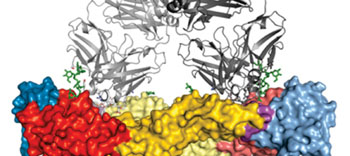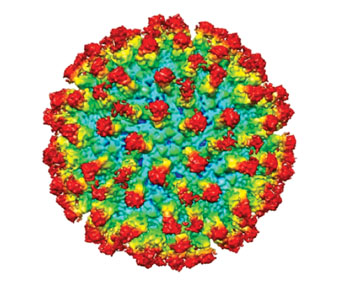Achilles Heel in Dengue Virus Discovered
By LabMedica International staff writers
Posted on 27 Apr 2015
Researchers have found new hope for a vaccine against dengue fever after discovering a vulnerable site on the surface of the Dengue virus that is targeted by the only broadly neutralizing human antibodies identified to date. Posted on 27 Apr 2015
The discovery, from research led by scientists at Imperial College London (London, UK) and Institut Pasteur (Paris, France), offers a new target for development of a vaccine to combat all 4 types (serotypes DEN-1, DEN-2, DEN-3, DEN-4) of Dengue virus currently in circulation. Though a patient produces antibodies specific to one serotype during an initial infection, these do not confer effective protection against subsequent infection by the other serotypes. These antibodies may even constitute a risk factor for developing a severe, often fatal form of dengue – dengue hemorrhagic fever. Any future vaccine against dengue must therefore provide effective, simultaneous protection against all four.
“Current vaccine trials have shown some promise but do not fully protect from infection. The finding of this new class of antibodies points the way for a new approach,” said Prof. Gavin Screaton of Imperial College. “Rather than binding to a single protein on the surface of the virus, these antibodies target a molecular bridge between two proteins. Although the 4 strains of Dengue virus have variations in their surface proteins, the molecular bridge is the same, enabling the antibodies to neutralize all the different types.”
The study identified the existence of a region in the Dengue virus envelope protein (VEP) that is exposed to antibodies to all 4 serotypes, suggesting that antibodies specific for this region may be effective in neutralizing the virus and so provide a promising target for an effective vaccine.
The team from Imperial College had already succeeded in identifying and isolating antibodies that simultaneously neutralize all 4 virus serotypes in a cohort of patients infected in Thailand. Such antibodies could themselves be used to protect against or treat infections; or vaccines could be devised. However, the mode of action of these antibodies remained unknown. In the new study, using the SOLEIL and ESRF synchrotron radiation facilities in Saint-Aubin (near Paris and Grenoble respectively), the scientists carried out a crystallographic analysis of the VEP in complex with these isolated antibodies in order to determine the 3D structure. Their analyses succeeded in identifying the antibody binding site on the VEP, and determined that the amino acid sequence at this site is identical in all 4 serotypes.
They also discovered that the VEP antibody binding site doubles as the binding site for the viral protein prM. Interaction between VEP and prM is crucial for the production of infectious viral particles during virus replication in infected cells. These observations provided insight into why this common binding site has been highly conserved despite the flaw it may appear to represent: a slight mutation on this site would enable the virus to evade the immune system but, at the same time, prevent the interaction with prM essential for replication.
This site may turn out to be the “Achilles heel” of the dengue virus. It opens new possibilities for developing a unique antigenic determinant to mimic this site that may trigger an immune response targeting all 4 serotypes simultaneously and so constitute a prime vaccine candidate against dengue.
The study, by Rouvinski A, et al, was published online January 12, 2015, in the journal Nature. The earlier study (on isolating the patient antibodies that recognize all 4 serotypes), by Dejnirattisai W, et al, was published online December 15, 2014, in the journal Nature Immunology.
Related Links:
Institut Pasteur
Imperial College London
Centre national de la recherche scientifique (CNRS)
















